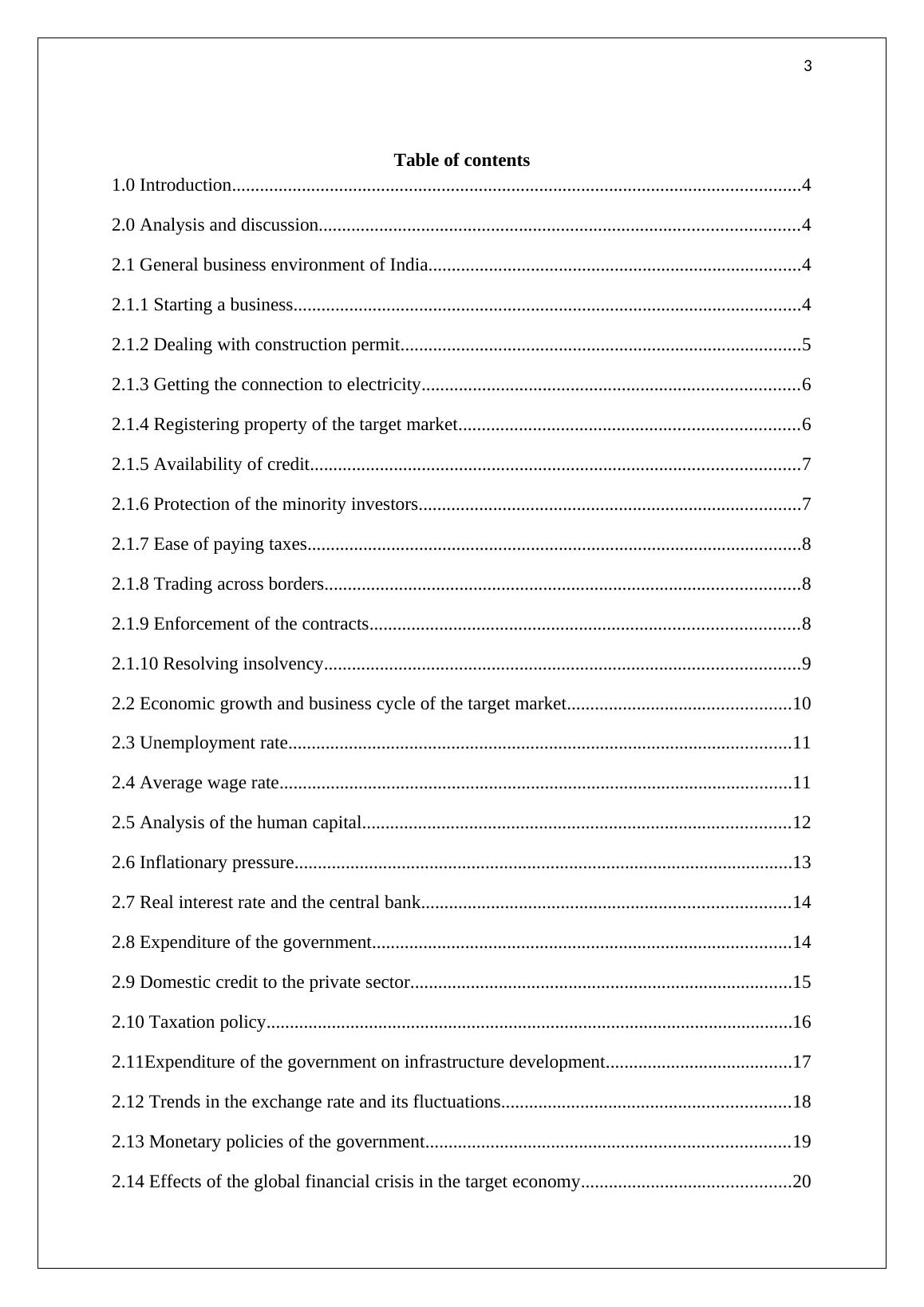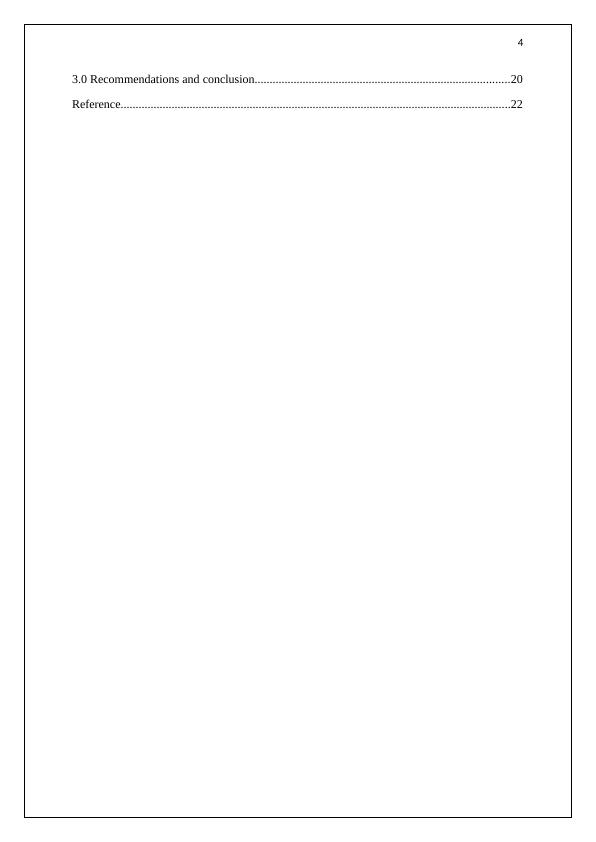(PDF) Changing Scenario of India's Business Environment
27 Pages8116 Words33 Views
Added on 2021-05-31
(PDF) Changing Scenario of India's Business Environment
Added on 2021-05-31
ShareRelated Documents
1MACROECONOMIC POLICYINDIA’S BUSINESS ENVIRONMENT AND ECONOMY

2Executive summaryThis paper contains a report directed to the CEO of the Australian investment companyregarding nature and the characteristics of the target market. The study of the paper aims tohelp the decision maker of the company regarding a long-term investment in one of the tradepartners of Australia that in this case in India. Using the data from the World Bank andstudies from the other sources regarding the performance of Indian economy, the paper hasshowcased the characteristics of Indian economy and its likeliness to become a target marketfor the Australian investment organisation.

3Table of contents1.0 Introduction..........................................................................................................................42.0 Analysis and discussion.......................................................................................................42.1 General business environment of India................................................................................42.1.1 Starting a business.............................................................................................................42.1.2 Dealing with construction permit......................................................................................52.1.3 Getting the connection to electricity.................................................................................62.1.4 Registering property of the target market.........................................................................62.1.5 Availability of credit.........................................................................................................72.1.6 Protection of the minority investors..................................................................................72.1.7 Ease of paying taxes..........................................................................................................82.1.8 Trading across borders......................................................................................................82.1.9 Enforcement of the contracts............................................................................................82.1.10 Resolving insolvency......................................................................................................92.2 Economic growth and business cycle of the target market................................................102.3 Unemployment rate............................................................................................................112.4 Average wage rate..............................................................................................................112.5 Analysis of the human capital............................................................................................122.6 Inflationary pressure...........................................................................................................132.7 Real interest rate and the central bank...............................................................................142.8 Expenditure of the government..........................................................................................142.9 Domestic credit to the private sector..................................................................................152.10 Taxation policy.................................................................................................................162.11Expenditure of the government on infrastructure development........................................172.12 Trends in the exchange rate and its fluctuations..............................................................182.13 Monetary policies of the government..............................................................................192.14 Effects of the global financial crisis in the target economy.............................................20


51.0 IntroductionLong-term investment decision of any country requires a lot of research and analysis. One ofthe important features of the long-term investment in the foreign country is that it is affectedhighly by its economic affairs. The study presents a report to the management of anAustralian investment company that is looking to invest in the air transport industry of India.The paper focuses on the study of the Indian economy at the macro level in order to getinsight regarding the behaviour and the potential performance in the future. While thefavourable policies of the government will allow the Australian company to have a higherreturn on their investment, any kind of unfavourable situation or changes in themacroeconomic variable can hamper the progress of the company. Apart from that, the paperalso examines the behaviour of the government regarding the expenditure of the governmentin a different sector of the economy in order to find out any potential benefit that the targetcountry may offer. 2.0 Analysis and discussion2.1 General business environment of IndiaThis general business environment of the target market is expected to provide currentinformation regarding the economic operation and the role of the government. Theknowledge of these economic indicators and behaviours will make it easier for the CEO toundertake long-term investment decision in the target country which in this case in India.2.1.1 Starting a businessHistorically, starting a new business have been challenging due to a high level of bureaucracyin India. However, there are few steps which need to be followed in order to introduce a newbusiness in India. 1.Research regarding the business opportunity of the market2.Having some legal assistance regarding the structure of the organisation.3.Deciding on the legal structure of the organisation based on the financial capabilitiesand the number of ownership (Varghese et al. 2016). 4.Getting the organisation incorporated as a business in India. 5.Setting a name of the company such that it does not become similar to an existingregistered company in the country.6.Verification of the visas and passport of the owners and the directors of the company. The overall process to register a business and start operating regularly takes more than 3months in case of India. Agrawal (2015) commented that this is due to the presence of highbureaucracy in the structure of the administration of the country. However, the government

6recently has come up with policies for the startup in which they get funding initially as aform of support and appreciation. 2.1.2 Dealing with a construction permitA construction permit is a clearance from the administration regrinding the establishment ofthe business. Kaushal and Pathak (2015) pointed out that in terms of the permission, India isthe worst place to start a business as each of the major cities of the country takes a lot of timeto clear the permission. AhmedabadBengaluruBhubaneshwarChennaiGurgaonGuwahatiHyderabadIndoreJaipurKochiKolkataLudhianaMumbaiNewDelhiNoidaPatnaRanchi050010001500200025003000Dealing with the construction permitTime (days)Cost (% of warehouse value)Figure 1: dealing with construction permits in different cities of India(Source: World Bank Open Data | Data. 2018)In addition to the extended time for the permission, the cost of issuing the permission is alsovery high for few of the cities of the country. While the cost of issuance of permit for theconstruction is very high for Kolkata and Mumbai, they are comparatively cheap for Chennaior Bangalore given the value these locations have in the economic map of the country. There are few of the steps which need to be followed in order to get permission forconstruction in India. These are furnished below:1.The company needs to confirm the land which is entitled to the permission from theadministration for new construction (Kaushal and Pathak, 2015). 2.Collection of the clearance certificate pertaining to the selected land.3.Collection of the building approval from the administration upon the submission ofthe zonal clearance and other land documents.

End of preview
Want to access all the pages? Upload your documents or become a member.
Related Documents
Trends and Cycles in China's Macroeconomylg...
|35
|8957
|31
Macroeconomics Assignment | Economics Assignmentlg...
|32
|6992
|56
Macroeconomic Policies of Indialg...
|14
|4696
|115
Development Context in India: Poverty Problemlg...
|16
|4396
|185
Poverty: development problem in Indialg...
|16
|4303
|31
Assignment on Macroeconomic Environment of Australialg...
|19
|3617
|26
